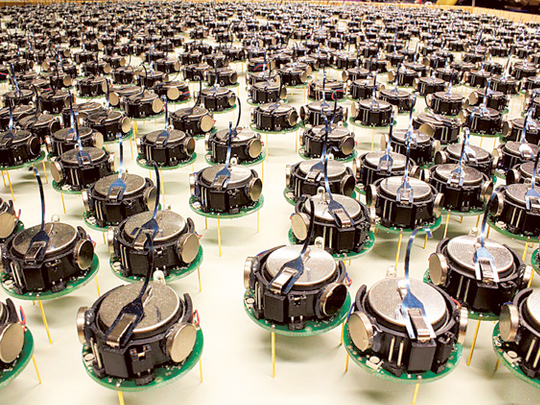
Washington: Here comes the swarm. Scientists at Harvard University have created the first 1,000-strong swarm of robots that can assemble themselves into different shapes upon command.
Using 1,024 three-legged robots roughly the size of a pingpong ball, the robo-swarm could form all kinds of shapes — a K, a star, a wrench — without any human intervention along the way. These “kilobots,” described in the journal Science, could help researchers build teams of robots that could work together in powerful ways.
Intelligent collective behaviour can be found throughout nature, from birds flying in a flock to cells in the body. Ants are prime examples. They’re nearly blind and not especially smart, and must rely on limited information from their neighbours. But as a colony, they can act like a smart superorganism, quickly building complex, river-worthy rafts with their bodies to survive floods.
“We look at ants and schools of fish for ideas on how they interact with each other,” said lead author Michael Rubenstein, a computer scientist at Harvard University. “We’re inspired by trying to understand these natural systems.”
Scientists and engineers want to take advantage of these phenomena by building small robots that can work together to perform complicated, large-scale tasks. They’ve created adorably tiny flying robots that could only fly solo. Another team anchored by Harvard’s Radhika Nagpal created robotic termites, which can build simple structures as a team — but only in small numbers.
The problem is that designing the algorithms that are robust enough to handle a thousand-strong swarm is even harder than it sounds — robot swarms tend to range from 10 to 50 members, and infrequently topped 100. It’s just as difficult to build that many robots, and to keep the cost of constructing them down.
To tackle these issues, the Harvard researchers built robots with twiggy stilts for legs — wheels are expensive to make. These bots use vibrating motors to skitter across a surface, rather in the way a phone can drift across a table when it vibrates.
Like individual ants, these robots are not particularly adept or powerful alone. They’re myopic, and they’d probably fail a sobriety test — they can’t always walk in a straight line. But their collective movement smooths out missteps as the bots move around following a specific set of rules encoded in the algorithm.
Here’s how the robot swarm starts: The scientists designate a clump of four robots as the “seed” for the shape. Other kilobots move along the edges of the growing clump to fill up the shape. They can do this because the seed robots send out a signal that helps nearby robots gauge where they are in a “map” of the shape they want to make. While each robot doesn’t know its own exact position, they can orient themselves according to their nearest neighbours. (For now, these bots can’t make shapes with holes in the middle, so doughnuts are out of the question.)
These kilobots, then, still need a blueprint of sorts to do their work. Rubenstein says he hopes one day such swarming robots could create dynamic structures that could react to their environment and build a structure that works with their surroundings, without needing a specific plan. If they’re able to link together — becoming the bricks as well as the builders — such robots could be dropped into disaster zones, or sent to harsh planets like Mars to build shelters for humans.
— Los Angeles Times












